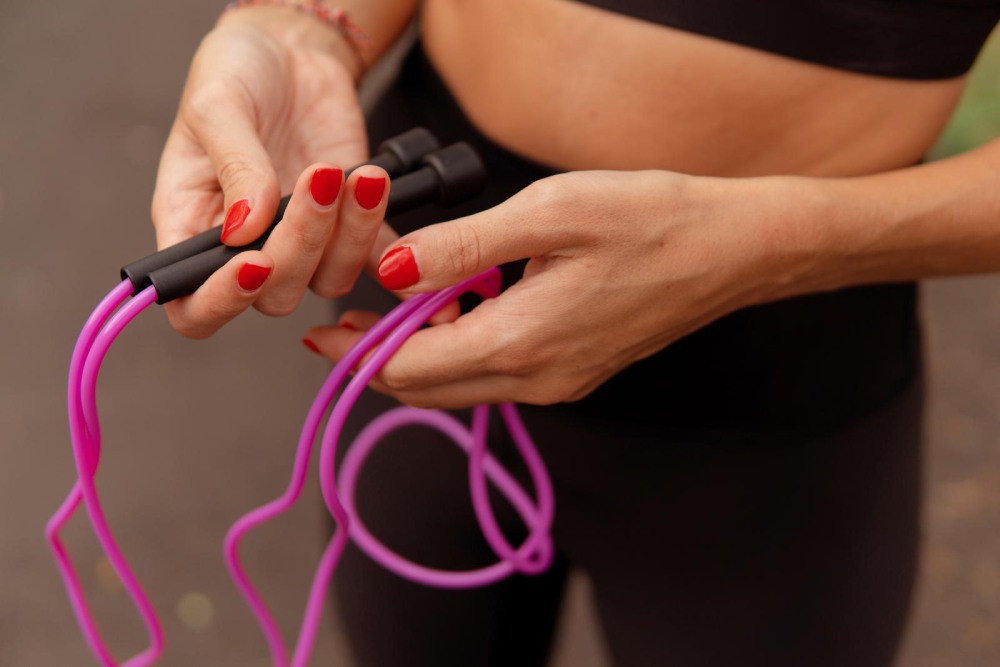Jumping ropes have a lot of benefits, but there might be a con. Is jumping rope bad for your knees? Find out if this exercise can help or hurt your runs.
Jumping rope is a fun exercise that’s a great way to shake up your workout routine. You’ve probably heard people say that jumping rope isn’t suitable for people with bad knees or it can harm your knees over time. That’s not necessarily the case; jumping rope is not harmful to your knee health when done correctly.
Factors such as overtraining, improper form, repeated high-impact footfalls, wearing the wrong shoes, and more can cause harm to your knees, leading to more pain and injuries. Let’s dive in.
Contents
Jumping Rope: The Benefits

For those looking to lose weight, according to Harvard Health Publishing, a person weighing 155 pounds can burn around 372 calories per 30-minute session jumping rope.
Jumping rope can achieve both goals quite quickly, as you can alter the intensity of the workout to fit your fitness level and skill. Besides the large number of calories burned by jumping rope, the exercise also contributes to improved heart health, reduces the chances of developing certain diseases, and increases overall physical wellness. According to the American Heart Association, you can reduce the risk of heart disease by maintaining an active lifestyle that includes regular exercise.
Exercise like jumping rope can also reduce your chances of developing type 2 diabetes. You also improve bone health and lower the risk of injury from falls. Check out our guide on can you run barefoot on a treadmill.
Plus, the American Council of Exercise reports that jumping rope can build stronger calf muscles while improving the elasticity of surrounding fascia and tendons, reducing the risk of lower-leg injuries. This greatly benefits anyone troubled with muscle or joint pain in their ankles, hips, feet, and knees, but consult a medical professional before beginning a new exercise plan.
Jumping Rope: The Downsides

Like many forms of exercise, jumping rope has its benefits and downsides. While many downsides can be resolved, there are certain situations where it might be best to choose another cardio exercise option. You might also wonder, is running on the road bad for your knees?
For example, for those with chronic pain in their joints and existing injuries, especially in their ankles, knees, and feet, it may be best to consult your physical therapist or doctor to determine if your body can handle the rigors of jumping rope.
The Arthritis Foundation notes that engaging in high-impact exercises involving both feet leaving the ground is not a good idea for those with tender joints. If you find that jumping rope causes too much discomfort, you may consider low-impact alternatives such as stationary cycling in the most accessible gear, pool walking or jogging, swimming, water aerobics, gentle yoga, or walking.
Also, jumping rope too often can build many harmful side effects as you overtrain muscles and strain joints and ligaments. Rest is vital when making stronger tissues. However, you can perform “active rest” activities by cross-training other exercises focusing on different parts of your body, thus providing certain areas with the rest they need while engaging other muscle groups.
Tips To Protect Joints While Jumping Rope
To enjoy the benefits of jumping rope without the pain and injuries, you can protect your joints using a few helpful tips.
- Keep your jump rope low to the ground: By reducing the space your feet need to clear from the ground, you can reduce the amount of shock your joints absorb from jumping. The idea is to clear the rope just enough while keeping it as low to the ground as possible.
- Wear the right shoes: Wearing well-fitted running or cross-training shoes can provide you with the support and comfort you need for high-impact exercises such as jumping rope and running.
- Choose a more forgiving surface: As a kid, you may have jumped rope on the sidewalk, but as an adult with joint issues, that surface is ill-advised. Choose a surface that offers a softer landing, like grass, mats, or particular shock-absorbing flooring.
- Soft landing: In addition to picking a suitable surface, you also want to practice landing softly by focusing on landing lightly on the balls of your feet to reduce shock.
FAQs On Is Jumping Rope Bad For Your Knees?
Does jumping rope burn muscle?
Jumping rope can be a very intense cardio exercise that burns a lot of calories quickly. This means that if you’re consuming very few calories daily while engaging in hours of high-intensity exercise, it’s possible to begin burning muscle instead of fat, depending on your BMI. You should always ensure you eat enough healthy calories when engaging in high-intensity or moderate-intensity exercise, as your body needs fuel to perform at its best and rest after exercising correctly.
Do you need to warm up or stretch before jumping rope?
Performing dynamic stretching before jumping rope and static stretching after can reduce your chance of injury while keeping your body limber and reducing soreness.



